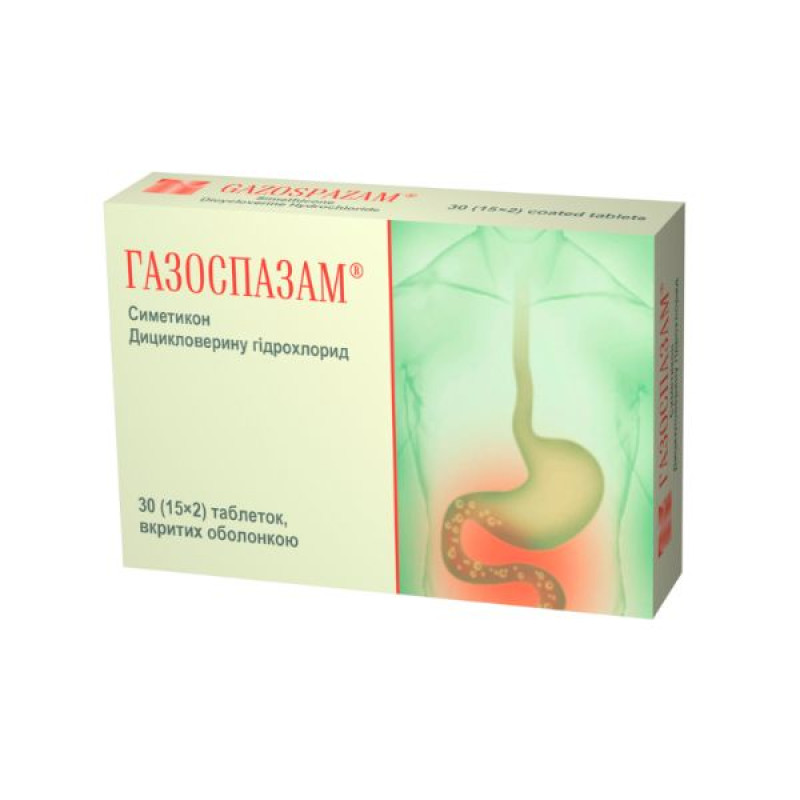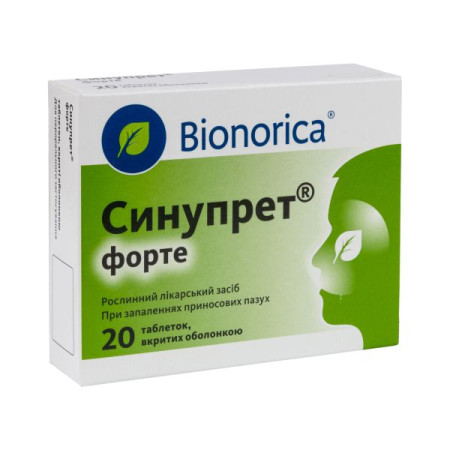Gas spasms film-coated tablets blister pack No. 30

Instructions for Gasospasam film-coated tablets blister pack No. 30
Composition
active ingredients: simethicone, dicycloverine hydrochloride;
1 tablet contains simethicone 125 mg, dicycloverine hydrochloride 20 mg;
excipients: magnesium aluminum silicate, lactose monohydrate, microcrystalline cellulose, calcium hydrogen phosphate, stearic acid, colloidal anhydrous silicon dioxide, crospovidone, povidone K29/32, Opadry II 85G 54275 pink: iron oxide red (E 172), lecithin, polyethylene glycol, polyvinyl alcohol, talc, titanium dioxide (E 171).
Dosage form
Film-coated tablets.
Main physicochemical properties: oval biconvex tablets, smooth on both sides, coated with a pink coating.
Pharmacotherapeutic group
Antispasmodics and anticholinergics in combination with other drugs. Antispasmodics in combination with other drugs.
ATX code A03E D.
Pharmacological properties
Pharmacodynamics
Gazospazam® is a combination drug that combines two drugs: dicycloverine hydrochloride and simethicone.
Dicyclomine hydrochloride has an antispasmodic effect (relieves spasm of smooth muscles in the gastrointestinal tract, abdominal pain associated with this spasm or with stretching of the gastrointestinal tract wall) and an antisecretory effect on the excretory glands. The action of dicyclomine is achieved due to a specific anticholinergic (antimuscarinic) effect on acetylcholine receptors, as well as a direct antispasmodic effect on smooth muscles. Studies have shown that dicyclomine is equally effective in spasms induced by acetylcholine and barium chloride. The effect of atropine on spasm caused by barium chloride is 200 times weaker than its effect on acetylcholine-induced spasm. The mydriatic effect of dicyclomine and its effect on salivary gland secretion are insignificant compared to the effects of atropine (1/500 and 1/300, respectively).
Simethicone is a surfactant, an antifoam. The mechanism of action is based on reducing the surface tension of gas bubbles, which contributes to the free removal of gases from the gastrointestinal tract or their absorption by the intestinal wall. Simethicone improves the quality of radiographs and sonograms, provides better distribution of contrast agents on the intestinal mucosa.
Pharmacokinetics
Dicyclomine hydrochloride is rapidly absorbed from the gastrointestinal tract after oral administration, with peak plasma concentrations achieved within 60-90 minutes; excreted mainly in the urine (79.5% of the administered dose), and partially in the feces (8.4%). The mean elimination half-life is 1.8 hours. The mean volume of distribution is 3.65 l/kg.
Simethicone is a physiologically and chemically inert substance; it is not absorbed and is excreted unchanged after passing through the digestive tract.
Indication
Treatment of conditions accompanied by spasm of smooth muscles of the gastrointestinal tract and flatulence, as well as associated abdominal pain. Treatment of spastic conditions of the gastrointestinal tract, including colitis, intestinal colic, irritable bowel syndrome, spastic constipation. As an additional treatment of organic diseases of the gastrointestinal tract in colitis, diverticulitis, enteritis, gastritis, peptic ulcers.
Contraindication
Hypersensitivity to the components of the drug. Obstructive diseases of the gastrointestinal tract, paralytic ileus, pyloric stenosis of the gastrointestinal tract with obstruction, severe ulcerative colitis or toxic megacolon, reflux esophagitis. Obstructive diseases of the biliary tract. Renal failure, obstructive diseases of the urinary tract, prostate adenoma with difficulty urinating. Glaucoma. Myasthenia gravis. Thyrotoxicosis. Heart failure, unstable state of the cardiovascular system with acute bleeding.
Interaction with other medicinal products and other types of interactions
Amantadine, class I antiarrhythmic drugs (e.g. quinidine), antihistamines, antipsychotics (e.g. phenothiazines), benzodiazepines, monoamine oxidase inhibitors, narcotic analgesics (e.g. meperidine), nitrates and nitrites, sympathomimetics, tricyclic antidepressants, corticosteroids and other drugs with anticholinergic activity may enhance the effects or side effects of dicyclomine.
Anticholinergic drugs can neutralize the effect of antiglaucoma drugs, so the drug should be prescribed with caution in cases of increased intraocular pressure and concomitant use of corticosteroids.
Anticholinergic agents enhance the effects of digoxin, salicylic acid, pyrazolone, codeine, caffeine and other anticholinergic agents (e.g. atropine sulfate), therefore their simultaneous use with dicycloverine hydrochloride is not recommended.
Dicyclomine can neutralize the effect of drugs that alter gastrointestinal motility, such as metoclopramide. Potentiates the effect of antispasmodics.
The inhibitory effect of anticholinergic agents on the secretion of hydrochloric acid in the stomach can be neutralized by drugs used to treat achlorhydria and study gastric secretion.
The absorption of levothyroxine in the intestine may be impaired when taken simultaneously with simethicone.
Application features
At high ambient temperatures during treatment with the drug, overheating of the body is possible (increased body temperature and heat stroke due to decreased sweating). If relevant symptoms appear, it is necessary to stop using the drug and consult a doctor.
Diarrhea may be an early symptom of incomplete intestinal obstruction, especially in patients with an ileostomy or colostomy. In such cases, the drug should not be used.
In individuals with individual hypersensitivity to anticholinergics, the drug may cause central nervous system effects such as confusion, disorientation, ataxia, increased fatigue or, conversely, euphoria, agitation, insomnia, and affective state. These symptoms usually disappear within 12 to 24 hours after discontinuation of the drug.
Gasospazam® should be used with caution in patients with autonomic neuropathy, liver or kidney disease, ulcerative colitis (taking high doses can cause paralytic ileus and the development or exacerbation of such a serious complication as toxic megacolon), arterial hypertension, ischemic heart disease, congestive heart failure, tachyarrhythmias, tachycardia, hiatal hernia and prostatic hypertrophy.
Excipients: This medicinal product contains lactose. If you have been told by your doctor that you have an intolerance to some sugars, contact your doctor before taking this medicinal product.
Ability to influence reaction speed when driving vehicles or other mechanisms
Dicycloverine hydrochloride can cause drowsiness and blurred vision, therefore it is not recommended to drive vehicles and complex mechanisms that require increased concentration and high speed of psychomotor reactions while taking the drug.
Use during pregnancy or breastfeeding
The safety of treatment with dicyclomine and simethicone during pregnancy has not been established, so the drug should not be used by pregnant women.
Since dicycloverine hydrochloride passes into breast milk, the drug should not be used during breastfeeding.
Method of administration and doses
Adults and children over 12 years of age: 1 tablet up to 4 times a day.
The maximum daily dose is 4 tablets.
The drug is recommended to be taken before or after meals. It is not recommended to take the drug for more than 5 days.
Children
Do not use in children under 12 years of age.
Overdose
Overdose is characterized by a two-phase nature: first, central nervous system excitation occurs, which is manifested by restlessness, the appearance of illusions, hallucinations, persistent mydriasis, tachycardia, and arterial hypertension. Then, central nervous system depression occurs, up to a comatose state.
Symptoms: headache, nausea, vomiting and abdominal pain, decreased appetite, pale skin, increased intraocular pressure, dizziness, blurred vision, dilated pupils, hot and dry skin, dry mouth, difficulty swallowing, central nervous system excitation, tachycardia, change in respiratory rate.
Curare-like effects (neuromuscular blockade, feeling of muscle weakness and paralysis) may occur.
Treatment: symptomatic therapy. In the first hours, it is recommended to induce vomiting, perform gastric lavage, and use adsorbents.
Diazepam (0.5% solution, 2 ml) is used to relieve psychomotor agitation.
Adverse reactions
The following side effects are related to the group of anticholinergic drugs, not all of them have been observed with the use of dicycloverine hydrochloride:
On the part of the digestive tract: dry mouth, loss of taste, anorexia, nausea, vomiting, indigestion, feeling of bloating, abdominal pain, constipation.
Central nervous system: tinnitus, headache, drowsiness, weakness, nervousness, psychosis, numbness, dizziness, coma, confusion and/or agitation (especially in elderly patients), dyskinesia, insomnia, disorientation, short-term memory loss, hallucinations, dysarthria, ataxia, euphoria, inadequate emotional reactions (symptoms decrease 12-24 hours after dose reduction).
On the part of the organs of vision: blurred vision, double vision, pupil dilation, accommodation paralysis, increased intraocular pressure (short-term atropine-like effects that disappear after discontinuation of dicyclomine).
Skin/allergic reactions: hypersensitivity reactions, including allergic dermatitis, pruritus, rash, urticaria, erythema, drug idiosyncrasy, angioedema, anaphylactic shock.
From the genitourinary system: difficulty urinating, urinary retention.
Cardiovascular system: tachycardia, feeling of increased heartbeat.
Other effects: decreased sweating, sneezing, swelling of the throat mucosa, suppression of lactation.
Expiration date
2 years.
Storage conditions
Store in the original packaging at a temperature not exceeding 25 °C.
Keep out of reach of children.
Packaging
15 tablets in a blister; 2 blisters in a cardboard box.
Vacation category
Without a prescription.
Producer
"KUSUM FARM" LLC.
Location of the manufacturer and its business address
40020, Ukraine, Sumy region, Sumy city, Skryabina st., 54.
There are no reviews for this product.
There are no reviews for this product, be the first to leave your review.
No questions about this product, be the first and ask your question.










